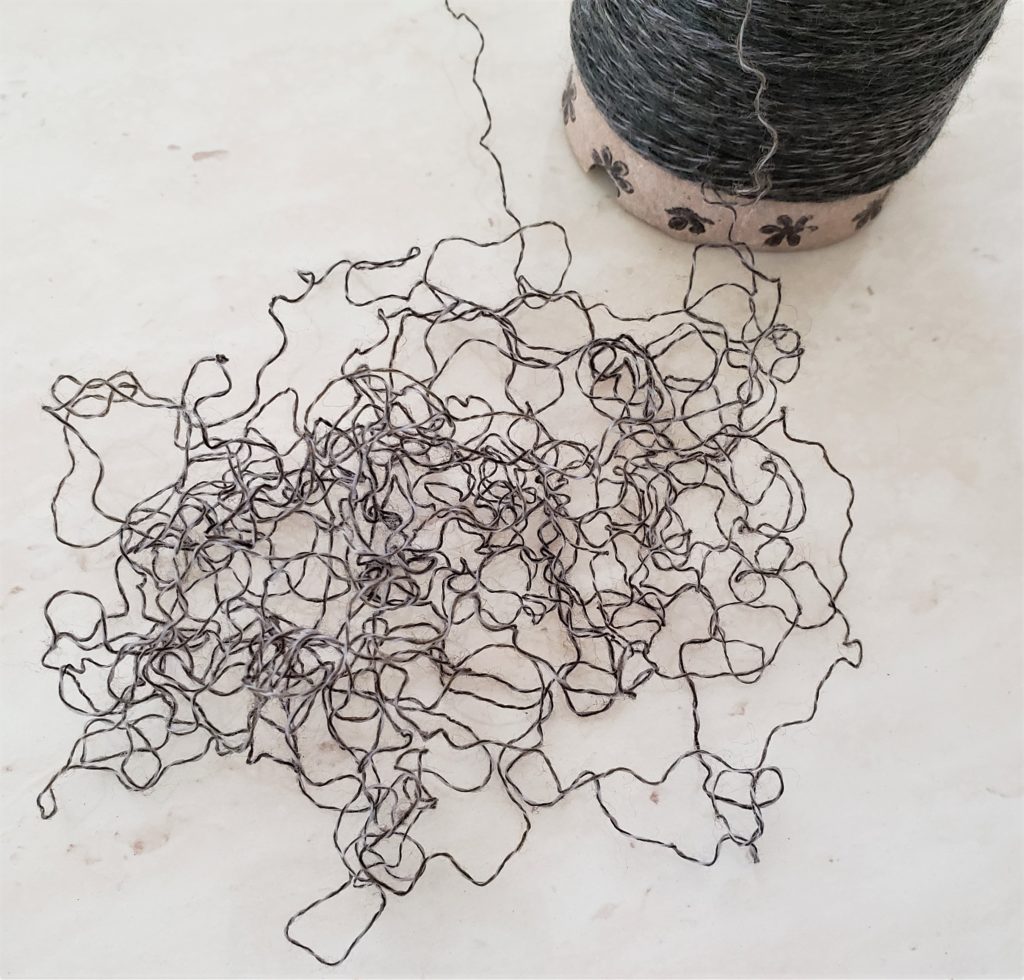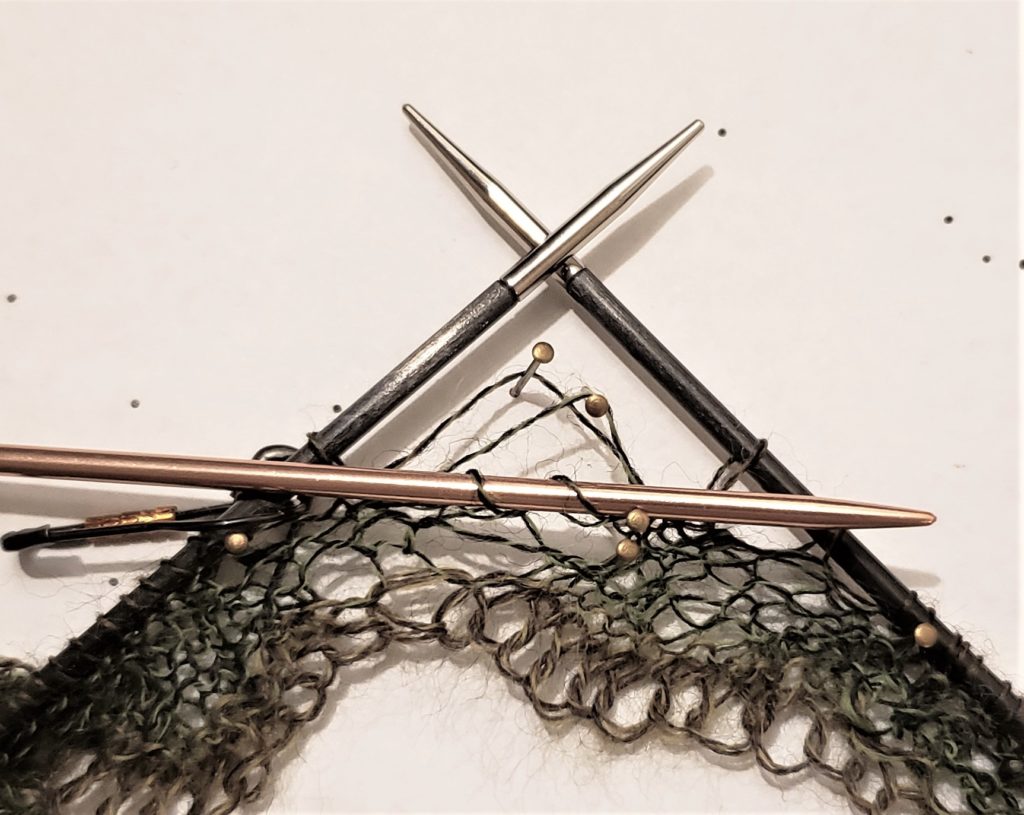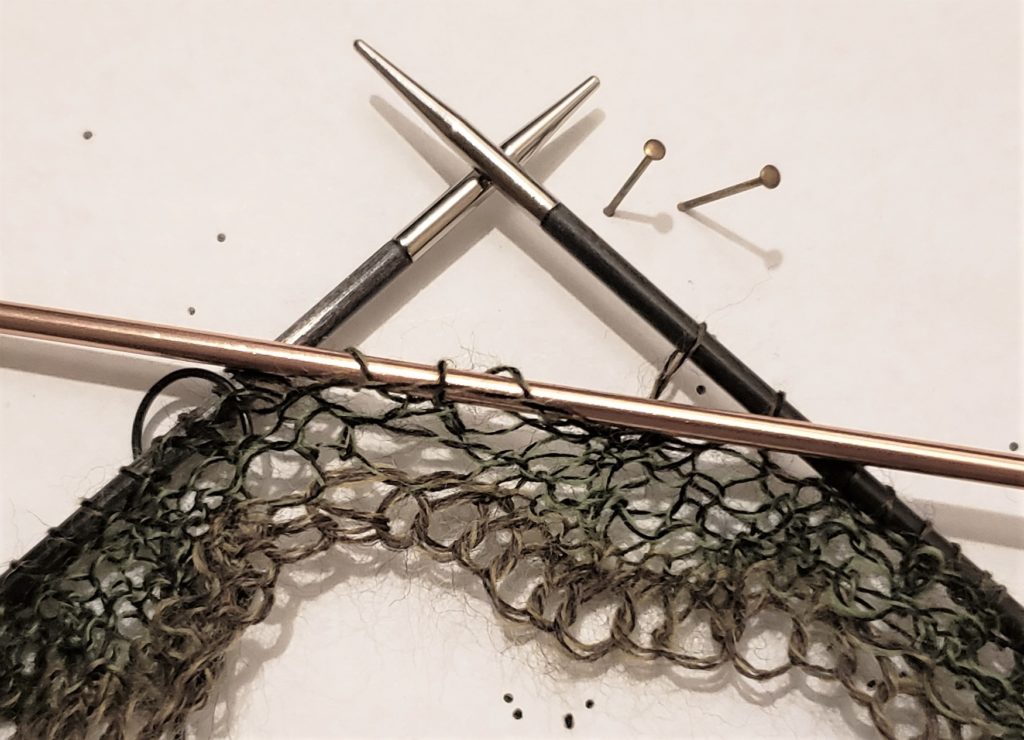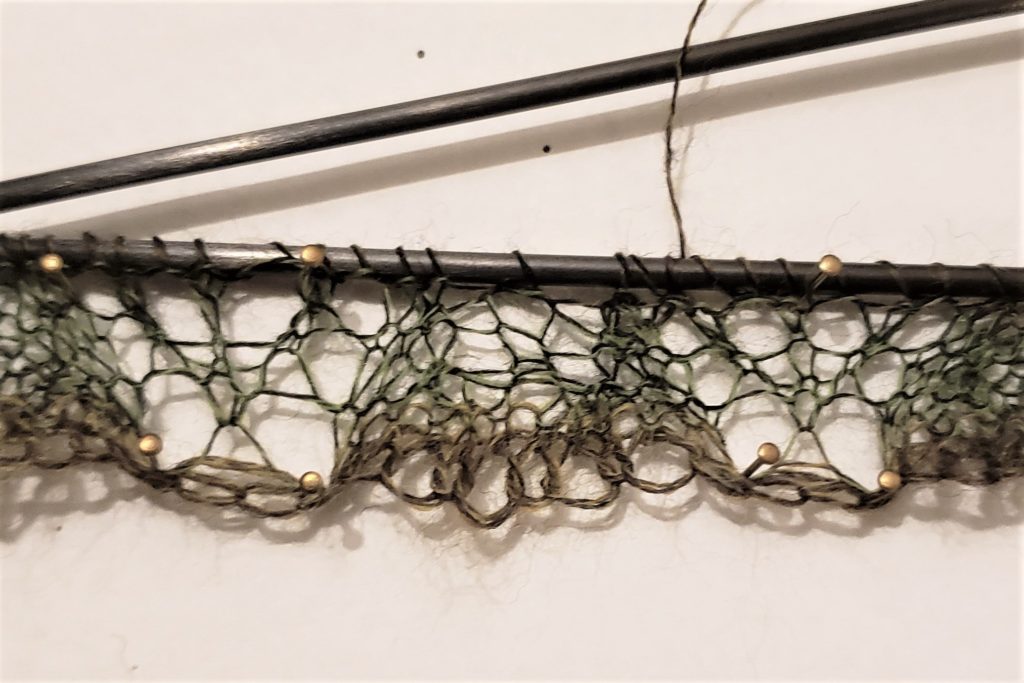
I think the number of mistakes I’ve made in my final edging piece of this Haapsalu shawl are a sign of how over this project I am. Now, this is my first true fine lace project, my first experience with nuups, and my first time diving deeply into the culture and history of Estonian lace, and I’ve truly enjoyed knitting this piece. Okay, so maybe I’m not a fan of nuups.
This is where I began, and it is evident that I struggled with those nuups from the start.
I still don’t even know where I went wrong with them. However, in my actual piece, each one was carefully and thoughtfully made, and so each one is fully formed. A true success, albeit one that took me twice as long as an un-nuuped version to achieve.
So, that’s not where my difficulty has been. No, what I’ve learned through this project is that I know nothing about how actual stitches work. You see, I’ve been knitting since I was six (30 years), so it’s just second-nature in a way that speaking English is second-nature for me. Early in this project, I would try to describe to myself or envision how I form a knit stitch – how I hold the thread, how I insert the needle – and I just couldn’t do it. But stick some needles in my hand and I could do it blindfolded. And I don’t struggle in the least to learn new knitting techniques. If someone shows me something once, I pick it up, but I would find it extremely difficult to then explain that same concept to someone else. It’s a strange thing to realize that I can’t discuss the mechanics of something I could do in my sleep.
Now, I don’t often make (knitting) mistakes and I’m a complete perfectionist, but in fine lace one tiny error could result in me losing hours and hours of work because I just didn’t know how to fix them in fabric that intricate. And this was wholly because of my ignorance of stitch structures and relationships, particularly the decreases.
Enter Facebook Groups, YouTube, and Craftsy.com (formerly Blueprint, formerly formerly Craftsy). Once Facebook fell out of favor for witty quips and beautiful photos, I stumbled upon this rise of the Facebook Group and promptly joined six or seven communities devoted to various fiber arts. There is considerable overlap in membership, so I see the same faces across subjects and I love knowing that other people are just as thrilled by all things fiber as I am.
As a newly obsessive fine lace knitter, one of my favorite groups is focused on the lovely art of Shetland lace, and it is here that I have learned the most about the frustrations of dismantling 12 hours of work in 15 minutes at 3:00 a.m. They taught me why they call it “frogging” (because you “rip it, rip it”); they taught me why they call it “tinking” (tink = knit backwards). They taught me that I can fix minor mistakes without frogging or tinking anything, but that completely dismantling a work to fix a mistake is something that everyone experiences, and accepting a mistake and/or fixing it in finishing is also a valid solution. Thank god they taught me what lifelines are.


Some YouTube videos later, and I discovered how easy it is to put in a lifeline using the little tightening holes that come on interchangeable needle sets. Some videos show how to do it with a needle and thread, and if this is how you do it, I understand why you don’t do it often. But with interchangeable needles, you simply thread the hole with your lifeline string and knit as usual, pulling the string through at the end of the row, and voilà! One painless lifeline. It’s so easy that there’s literally no reason to not do it in lace. I even hate knitting with circular needles, so I’ll switch to one every twenty rows or so just to insert my next lifeline (and no, you can’t tell).
But, you see, I would get cocky. I would think to myself, “I haven’t made a mistake in weeks – I can make it another 20 rows without another lifeline,” and then 7 stiches before the end of my lifeline row I would slip and drop three stitches, and that would be the end of that. I would try to fix it, I would, I swear! But I would twist my stitches, or I’d drop more, so I’d pull out my needles and start pulling away at 6,000 stitches because once the mistake involved more than just a simple missing yarn over or a dropped knit stitch, I just couldn’t fix it without scrapping everything down to the last lifeline.

Just as in life, knitting mistakes happen; and, just as in life, it’s important to know how to fix your knitting mistakes when you make them. Just as in life, I’m not the best at fixing my knitting mistakes when they happen and where they are. It’s a skill one must learn through trial and patience; and so, when the opportunity arises, I always make my best attempt to repair what I’ve done. Unfortunately, more often than not, I would end up making it worse – just as in life.
Until recently. I’m not sure what changed, but maybe the Craftsy videos started to sink in. I got a premium membership on discount – unlimited videos for $40 (and no, I don’t get paid to promote them) – and found that their content is super helpful for people at all levels. So, I started to watch some content on new techniques, and a lot of their classes begin with a lesson on stitch structures. For someone who has never even thought about what direction a stitch should face, these videos helped me process things that I’ve basically been doing since before I was conscious.
The most helpful of these videos for me has been “Save our Stitches: Fixing Lace Knitting Mistakes” with Laura Nelkin. She does a segment on “Lace Surgery”, and boy, did it change my life. I had to watch it twice, two months apart, for it to sink in, but I don’t think I’ll ever have to frog again.
My edgings have 685 stitches each, and there are two. With the first one, I’d gotten to row 8 of 18 and dropped a few stitches while tired one night. I fixed it, but it didn’t look right, and so I tried fiddling with it again and I made a hole, and the hole got bigger and bigger, and – crying – I pulled out days of work and started again. I’m now on the second one. It’s the home stretch. I’m almost done with this damned scarf I’ve been knitting since April that’s longer than I am tall.

And again at row 8, I slipped and lost six stitches. They laddered down, and I caught them at row 4. Again, I cried. Again, I fixed it, but it didn’t look right. I talked to my husband. He said leave it, that no one would notice, but my OCD won’t allow for that. I could maybe leave a twisted stitch or some wonky tension, but I had a twisted row. There had to be another way. Again, I watched that video on lace surgery – and would you believe it, this time something stuck. The key is having something good to pin it to. This is not a handheld activity. I used a bobbin lace pillow that has never been used for bobbin lace.
My first attempt at surgery worked fine enough, but it wasn’t perfect. Somehow I missed a stitch, but I didn’t notice until the return row. So I did a second round of surgery. I couldn’t breathe as I pulled out those stitches and knitted them up again. I found it easiest to dismantle the stitches between two knitted columns in my pattern (non-inclusive) so I would have an intact knit stitch on either side in each row as reference.




As you can see, surgery really distorts things, but in comparing the rebuilt pattern with an intact version, the only difference I can really see is in the tension. I’m hoping that I can move things around in there while it’s blocking, and I’m convinced that it won’t be visible in the final. OCD satisfied. Another thing to note is that my two surgeries cost me an hour, whereas starting over probably would have cost me 8.
My journey through fine lace has been truly educational. The way that I knit has taught me so much about how I, myself, can handle life when it goes wrong. When knitting, I don’t leave any mistake unaddressed, I fix the minor ones a row or two down without much effort and I move on, and I breathe through the frogging of major ones and let those hours of work go (265 hours and counting, can you believe it?) – because the journey is the point. I’ve learned to put in those lifelines more often, especially when things are going well, just to be prepared for when they are not. I’ve learned to be patient and kind to myself, and I’m getting better at repairing those mistakes every day. My reward is flawless, delicate work that I can be proud of.
Now, to apply this to my non-knitting life…
